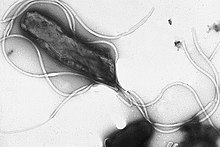Flagellin

Flagellin is a globular protein that arranges itself in a hollow cylinder to form the filament in a bacterial flagellum. It has a mass of about 30,000 to 60,000 daltons. Flagellin is the principle component of bacterial flagellum, and is present in large amounts on nearly all flagellated bacteria.
Structure
The structure of flagellin is responsible for the helical shape of the flagellar filament, which is important for its proper function.[1][2]
The N- and C-termini of flagellin form the inner core of the flagellin protein, and is responsible for flagellin's ability to polymerize into a filament. The middle residues make up the outer surface of the flagellar filament. While the termini of the protein are quite similar among all bacterial flagellins, the middle portion is wildly variable.
Immune response
In mammals
Mammals often have acquired immune responses (T-cell and antibody responses)[3] to flagellated bacterium, which occur frequently to flagellar antigens. Flagellin has also been shown to directly interact with TLR5 on T cells.[4] Some bacteria are able to switch between multiple flagellin genes in order to evade this response.
The propensity of the immune response to flagellin may be explained by two facts:
- Flagellin is an extremely abundant protein in flagellated bacteria.
- There exists a specific innate immune receptor that recognizes flagellin, Toll-like receptor 5 (TLR5).[5]
In plants
In addition, a 22-amino acid sequence (flg22) of the conserved N-terminal part of flagellin is known to activate plant defence mechanisms.[6] Flagellin perception in Arabidopsis thaliana functions via the receptor-like-kinase FLS2 (flagellin-sensitive-2)). Upon flg22 detection, FLS2 quickly binds to BAK1 (BRI1-associated kinase 1) to initiate signalling by reciprocal transphosporylation of their kinase domains.[7] Mitogen-activated-protein-kinases (MAPK) acts as downstream signalling compounds, leading ultimately to PAMP-triggered immunity in which more than 900 genes are up-/down-regulated upon flg22 treatment.
Pre-stimulation with a synthetic flg22-peptide led to enhanced resistance against bacterial invaders.
References
- ^ Theodore S. Steiner (21 November 2006). "How Flagellin and Toll-Like Receptor 5 Contribute to Enteric Infection". Infection and Immunity. 75 (2). American Society for Microbiology: 545–552. doi:10.1128/IAI.01506-06.
- ^ Ferenc Vonderviszt; Keiichi Namba. "Structure, Function and Assembly of Flagellar Axial Proteins". Austin, TX: Madame Curie Bioscience Database.
- ^ Genta, R.M. (1997). The immunobiology of Helicobacter pylori gastritis. Seminars in gastrointestinal diseases. 8(1):2-11
- ^ Sharma, N; et al. (2013). "Sphingosine-1-phosphate suppresses TLR-induced CXCL8 secretion from human T cells". J Leukoc Biol. 93 (4): 521–528. doi:10.1189/jlb.0712328. PMID 23345392.
- ^ Kathrani A, Holder A, Catchpole B, et al. TLR5 risk-associated haplotype for canine inflammatory bowel disease confers hyper-responsiveness to flagellin. PloS one 2012;7:e30117
- ^ Garcia, Ana Victoria; Hirt, Heribert (2014-01-01). "Salmonella enterica induces and subverts the plant immune system". Plant Biotic Interactions. 5: 141. doi:10.3389/fmicb.2014.00141. PMC 3983520. PMID 24772109.
{{cite journal}}: CS1 maint: unflagged free DOI (link) - ^ Chinchilla D., Zipfel C., Robatzek S., Kemmerling B., Nürnberger T., Jones J.D.G., Felix G. & Boller T. 2007 A flagellin-induced complex of the receptor FLS2 and BAK1 initiates plant defence, Nature 448, 497-500. doi:10.1038/nature05999 http://www.nature.com/nature/journal/v448/n7152/abs/nature05999.html
External links
- Flagellin at the U.S. National Library of Medicine Medical Subject Headings (MeSH)
- Bacterial flagellin and plant disease resistance, published by Zipfel. et al. (2004) Abstract Article
